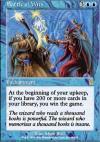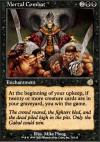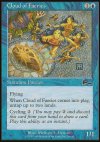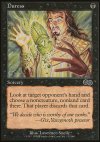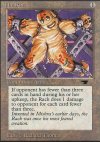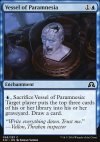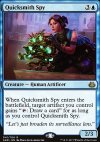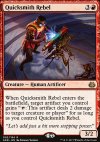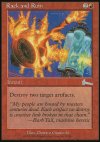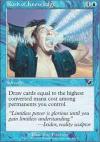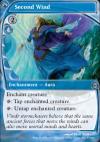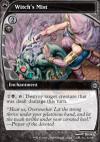|

MV anecdotes
| 951 anecdotes trouvées |   |
Les deux cartes Urza's Rebuff et Mishra's Onslaught, de l'édition The Brothers' War et illustrées par Josu Hernaiz, forment une paire. De plus leurs textes d'ambiance se font écho.
Les deux cartes Bladecoil Serpent et Clay Champion, de l'édition The Brothers' War, forment une paire.
Les cinq cartes Court of Ardenvale, Court of Vantress, Court of Locthwain, Court of Embereth et Court of Garenbrig, de l'édition Wilds of Eldraine Commander Decks, forment un cycle appelé "Court".
Ce cycle est inspiré d'un autre cycle paru dans l'édition Commander Legends (voir cette anecdote).
Le nom de chacun des enchantements fait référence au nom du terrain correspondant du cycle appelé "Castle" de l'édition Throne of Eldraine (voir cette anecdote).
Ce cycle est inspiré d'un autre cycle paru dans l'édition Commander Legends (voir cette anecdote).
Le nom de chacun des enchantements fait référence au nom du terrain correspondant du cycle appelé "Castle" de l'édition Throne of Eldraine (voir cette anecdote).
Les dix cartes Sharae of Numbing Depths, Obyra, Dreaming Duelist, Totentanz, Swarm Piper, Ruby, Daring Tracker, Syr Armont, the Redeemer, Neva, Stalked by Nightmares, Johann, Apprentice Sorcerer, Greta, Sweettooth Scourge, Ash, Party Crasher et Troyan, Gutsy Explorer, de l'édition Wilds of Eldraine, forment un cycle de créatures légendaires bicolores peu communes soutenant chacune un archétype de formats limités.
Source 1 (Wild at Heart) - Source 2 (Fairy-Tale Archetypes) - Source 3 ("Draft, as an example, had a big influence on the uncommon gold cards that model Draft archetypes")
Source 1 (Wild at Heart) - Source 2 (Fairy-Tale Archetypes) - Source 3 ("Draft, as an example, had a big influence on the uncommon gold cards that model Draft archetypes")
Source 1 a écrit :
[...] Building each draft archetype around a [fairy tale] story allowed us to give the set a unique feel that played into our key theme. Note that we were using the story as a jumping-off point and were doing our twist on it rather than just straight up repeating the story.
Here are the ten [two-color draft archetypes] we chose when we handed off the set from design, all of which made it to print:
White-Blue: The Snow Queen
This story obviously dealt with cold and ice, so blue seemed like a shoo-in. White seemed like the best color pair, as the effects white gave us worked best with the type of effects we wanted for the story.
Blue-Black: Sleeping Beauty
This story had to involve sleeping, which we've traditionally done in blue. It has a dark edge to it, so that made black feel like a good color to pair it with.
Black-Red: Pied Piper
Rats are black, and the Pied Piper controlling people with music felt blue or red. We already had a blue-black story we liked, and the archetype wanted to make a lot of Rat tokens, which felt more red than blue.
Red-Green: Little Red Riding Hood
The wolf, the huntsman, and the forest setting all felt very green. The second color wanted to be either black or red, and we liked black-green more for Hansel and Gretel.
Green-White: Beauty and the Beast
This was the color pair we had the hardest time with. It went through several changes, but we liked how green and white captured the wild and controlled elements of the story.
White-Black: Snow White
We knew we wanted our version of Snow White and the Evil Queen, so that put us squarely in white-black.
Blue-Red: The Sorcerer's Apprentice
This was another hard color pair to find the right story for. Blue-red wanted to deal with spells, so we had to find a story where magic went awry, and the Sorcerer's Apprentice was the best fit.
Black-Green: Hansel and Gretel
The hungry kids and forest setting felt green. The witch felt black. This was one of the first stories we settled on.
Red-White: Cinderella
We knew we wanted to do Cinderella, and it got moved all over. I think we ended up in red-white because we felt we could make it work there, and no other story seemed to fit as well.
Green-Blue: Jack and the Beanstalk
This is another one we struggled with. Green made perfect sense because of the beanstalk. Stealing everything from the giant felt blue.
Here are the ten [two-color draft archetypes] we chose when we handed off the set from design, all of which made it to print:
White-Blue: The Snow Queen
This story obviously dealt with cold and ice, so blue seemed like a shoo-in. White seemed like the best color pair, as the effects white gave us worked best with the type of effects we wanted for the story.
Blue-Black: Sleeping Beauty
This story had to involve sleeping, which we've traditionally done in blue. It has a dark edge to it, so that made black feel like a good color to pair it with.
Black-Red: Pied Piper
Rats are black, and the Pied Piper controlling people with music felt blue or red. We already had a blue-black story we liked, and the archetype wanted to make a lot of Rat tokens, which felt more red than blue.
Red-Green: Little Red Riding Hood
The wolf, the huntsman, and the forest setting all felt very green. The second color wanted to be either black or red, and we liked black-green more for Hansel and Gretel.
Green-White: Beauty and the Beast
This was the color pair we had the hardest time with. It went through several changes, but we liked how green and white captured the wild and controlled elements of the story.
White-Black: Snow White
We knew we wanted our version of Snow White and the Evil Queen, so that put us squarely in white-black.
Blue-Red: The Sorcerer's Apprentice
This was another hard color pair to find the right story for. Blue-red wanted to deal with spells, so we had to find a story where magic went awry, and the Sorcerer's Apprentice was the best fit.
Black-Green: Hansel and Gretel
The hungry kids and forest setting felt green. The witch felt black. This was one of the first stories we settled on.
Red-White: Cinderella
We knew we wanted to do Cinderella, and it got moved all over. I think we ended up in red-white because we felt we could make it work there, and no other story seemed to fit as well.
Green-Blue: Jack and the Beanstalk
This is another one we struggled with. Green made perfect sense because of the beanstalk. Stealing everything from the giant felt blue.
Source 2 a écrit :
Let's walk through each of the ten archetypes to talk about how Set Design handled them.
White-Blue: The Snow Queen
To match the flavor of the story, the archetype revolves around tapping and locking down creatures. Set Design liked the novelty of the archetype, but it required a lot of tweaking to ensure it wasn't unfun to play against. To solve this problem, the Set Design team decided to make it a tempo deck rather than a control deck.
Blue-Black: Sleeping Beauty
This archetype revolves around Faeries. Faeries both are most famously in blue and black and tie well to the Sleeping Beauty story. The challenge for Set Design is that all Faeries flavorfully need to fly, and building a typal deck with all fliers is very tricky. Set Design's solution for this problem was two-fold. First, they made it more of a control deck rather than a go-wide deck. Winning was about attacking with one or two Faeries, not a giant swarm. Second, they limited how many cards specifically referred to Faeries. It's more that the Faeries are the best control creatures rather than the deck being about rewarding having a lot of Faeries on the battlefield at once.
Black-Red: The Pied Piper of Hamelin
Vision Design had come up with the idea of Rat tokens that couldn't block since decks that spill out a lot of small creature tokens tend to lend themselves to be more defensive and do a good job of gumming up the battlefield. The Rat creature tokens, as handed off, allowed Set Design to be more aggressive with making them, which fit into the Rat swarm feel the fairy tale wanted. To further encourage attacking, Set Design added some rewards for your creatures dying. They also added in some sacrifice effects (along with bargain) to allow you to use the Rats as a resource if attacking wasn't an option.
Red-Green: Little Red Riding Hood
This was one of the archetypes that was handed off from Vision Design without a clear mechanical theme. Set Design liked to have one archetype that's more straightforward (less based on understanding synergy) for less-experienced drafters, and Little Red Riding Hood and its forest setting worked well for caring about bigger creatures. Set Design ended up making this archetype an aggressive midrange "beatdown" deck that just keeps casting bigger and bigger creatures and attacking.
Green-White: Beauty and the Beast
Green and white are the two colors that have the most enchantment synergy, so this archetype plays into that. While all archetypes use Roles, green-white uses them the most, especially relying on the Royal and Monster Roles, capturing the flavor of Beauty and the Beast.
White-Black: Snow White
White-black is one of the more complex archetypes. It rewards you for your own stuff dying, so it encourages Roles and other Auras, Food, and sacrifice and is the color most focused on using bargain. This is the antithesis of the red-green archetype in that it mostly relies on the understanding of the synergy between your cards.
Blue-Red: Sorcerer's Apprentice
Blue-red is traditionally the "spells matter" deck, blue and red being the colors with the lowest percentage of creatures and the highest percentage of spells. This archetype is less permanent focused and relies on things like prowess to encourage a lot of spellcasting.
Black-Green: Hansel and Gretel
Black-green ended up being the archetype about Food tokens. The color pair has candy monsters in it that get to be Food or create Food when they die. The candy monsters had shown up in initial world building, and everyone fell in love with them. A lot of the set design for this archetype was figuring out how to properly encourage other ways to use your Food tokens. The deck ended up being a midrange deck.
Red-White: Cinderella
As is normally the case, red-white is the archetype most focused on being aggro. Celebration was made specifically for this archetype, and it encourages using things like Roles and Equipment, so the Set Design team spent a lot of time making sure all the support cards were in red and white. The Adventures for this archetype tend to make Roles so that one card can generate two permanents.
Green-Blue: Jack and the Beanstalk
This was the other archetype that Vision Design handed off without a clear mechanical definition. Vision Design thought of making a control deck using Food tokens but decided that wouldn't be fun to play against. Set Design kept Food primarily black-green and decided to focus on a "mana value 5 or higher" theme. That led them to make this a ramp archetype and the archetype that cares about Adventures most. Its Adventures were small effects paired with bigger creatures.
White-Blue: The Snow Queen
To match the flavor of the story, the archetype revolves around tapping and locking down creatures. Set Design liked the novelty of the archetype, but it required a lot of tweaking to ensure it wasn't unfun to play against. To solve this problem, the Set Design team decided to make it a tempo deck rather than a control deck.
Blue-Black: Sleeping Beauty
This archetype revolves around Faeries. Faeries both are most famously in blue and black and tie well to the Sleeping Beauty story. The challenge for Set Design is that all Faeries flavorfully need to fly, and building a typal deck with all fliers is very tricky. Set Design's solution for this problem was two-fold. First, they made it more of a control deck rather than a go-wide deck. Winning was about attacking with one or two Faeries, not a giant swarm. Second, they limited how many cards specifically referred to Faeries. It's more that the Faeries are the best control creatures rather than the deck being about rewarding having a lot of Faeries on the battlefield at once.
Black-Red: The Pied Piper of Hamelin
Vision Design had come up with the idea of Rat tokens that couldn't block since decks that spill out a lot of small creature tokens tend to lend themselves to be more defensive and do a good job of gumming up the battlefield. The Rat creature tokens, as handed off, allowed Set Design to be more aggressive with making them, which fit into the Rat swarm feel the fairy tale wanted. To further encourage attacking, Set Design added some rewards for your creatures dying. They also added in some sacrifice effects (along with bargain) to allow you to use the Rats as a resource if attacking wasn't an option.
Red-Green: Little Red Riding Hood
This was one of the archetypes that was handed off from Vision Design without a clear mechanical theme. Set Design liked to have one archetype that's more straightforward (less based on understanding synergy) for less-experienced drafters, and Little Red Riding Hood and its forest setting worked well for caring about bigger creatures. Set Design ended up making this archetype an aggressive midrange "beatdown" deck that just keeps casting bigger and bigger creatures and attacking.
Green-White: Beauty and the Beast
Green and white are the two colors that have the most enchantment synergy, so this archetype plays into that. While all archetypes use Roles, green-white uses them the most, especially relying on the Royal and Monster Roles, capturing the flavor of Beauty and the Beast.
White-Black: Snow White
White-black is one of the more complex archetypes. It rewards you for your own stuff dying, so it encourages Roles and other Auras, Food, and sacrifice and is the color most focused on using bargain. This is the antithesis of the red-green archetype in that it mostly relies on the understanding of the synergy between your cards.
Blue-Red: Sorcerer's Apprentice
Blue-red is traditionally the "spells matter" deck, blue and red being the colors with the lowest percentage of creatures and the highest percentage of spells. This archetype is less permanent focused and relies on things like prowess to encourage a lot of spellcasting.
Black-Green: Hansel and Gretel
Black-green ended up being the archetype about Food tokens. The color pair has candy monsters in it that get to be Food or create Food when they die. The candy monsters had shown up in initial world building, and everyone fell in love with them. A lot of the set design for this archetype was figuring out how to properly encourage other ways to use your Food tokens. The deck ended up being a midrange deck.
Red-White: Cinderella
As is normally the case, red-white is the archetype most focused on being aggro. Celebration was made specifically for this archetype, and it encourages using things like Roles and Equipment, so the Set Design team spent a lot of time making sure all the support cards were in red and white. The Adventures for this archetype tend to make Roles so that one card can generate two permanents.
Green-Blue: Jack and the Beanstalk
This was the other archetype that Vision Design handed off without a clear mechanical definition. Vision Design thought of making a control deck using Food tokens but decided that wouldn't be fun to play against. Set Design kept Food primarily black-green and decided to focus on a "mana value 5 or higher" theme. That led them to make this a ramp archetype and the archetype that cares about Adventures most. Its Adventures were small effects paired with bigger creatures.
Les cinq cartes Test of Endurance, Battle of Wits, Mortal Combat, Chance Encounter et Epic Struggle, du bloc des éditions Odyssey, Torment et Judgment, forment un cycle.
Source (Battle of Wits - "[...] five win condition cards in one set was a little too much. [...] Torment, the black set [...] got the black one. Judgment, the white and green set [...] got the white and green ones. The blue and red ones ended up in the last set they could go in, which happened to be the first set.")
Source (Battle of Wits - "[...] five win condition cards in one set was a little too much. [...] Torment, the black set [...] got the black one. Judgment, the white and green set [...] got the white and green ones. The blue and red ones ended up in the last set they could go in, which happened to be the first set.")
Les cartes Cloud of Faeries, Peregrine Drake, Great Whale et Palinchron forment un cycle vertical (cartes d'une même couleur mais avec une rareté différente) du bloc des éditions Urza's Saga, Urza's Legacy et Urza's Destiny.
Les cartes Rewind, Time Spiral, Frantic Search, Snap et Treachery, du même bloc, partagent la même mécanique et s'apparentent à ce cycle.
Cette mécanique "free mechanic" ne fut plus jamais rééditée depuis lors sur des permanents et encore moins sur des créatures, facilement blinkables et bouncables, probablement en raison de l'abus de combos qu'elle offrait, souvent à base de mana à volonté (par exemple voir cette combo ou cette combo).
Source 1 (Rewind - "[...] it turns out that reactive free spells aren't nearly as problematic as proactive ones, because you don't control when you can use it.") - Source 2 (Frantic Search (restricted in Vintage) / Time Spiral (banned in Extended, restricted in Vintage) - "[...] Someday I'll do an article on the worst mechanics in Magic. The "free" mechanic has a special space reserved in that article.") - Search ~ Couleurs : seulement + "untap up to" lands.
seulement + "untap up to" lands.
Les cartes Rewind, Time Spiral, Frantic Search, Snap et Treachery, du même bloc, partagent la même mécanique et s'apparentent à ce cycle.
Cette mécanique "free mechanic" ne fut plus jamais rééditée depuis lors sur des permanents et encore moins sur des créatures, facilement blinkables et bouncables, probablement en raison de l'abus de combos qu'elle offrait, souvent à base de mana à volonté (par exemple voir cette combo ou cette combo).
Source 1 (Rewind - "[...] it turns out that reactive free spells aren't nearly as problematic as proactive ones, because you don't control when you can use it.") - Source 2 (Frantic Search (restricted in Vintage) / Time Spiral (banned in Extended, restricted in Vintage) - "[...] Someday I'll do an article on the worst mechanics in Magic. The "free" mechanic has a special space reserved in that article.") - Search ~ Couleurs :
 seulement + "untap up to" lands.
seulement + "untap up to" lands.Les deux cartes Duress et Ostracize, du bloc des éditions Urza's Saga, Urza's Legacy et Urza's Destiny, forment une paire.
Source (Duress)
Source (Duress)
Les deux cartes Lightbringer et Lawbringer, de l'édition Nemesis, forment une paire de "Color-Hosers". De plus leurs textes d'ambiance se font écho.
Les deux cartes Rackling et Viseling, ainsi que les deux cartes Wheel of Torture et Iron Maiden, forment une paire qui est une référence à la paire formée par les cartes The Rack et Black Vise :
• la paire de l'édition Urza's Legacy en est une version pour le jeu multijoueurs ;
• la paire de l'édition Nemesis en est une version créature et pour le jeu multijoueurs. De plus leurs textes d'ambiance se font écho.
• la paire de l'édition Urza's Legacy en est une version pour le jeu multijoueurs ;
• la paire de l'édition Nemesis en est une version créature et pour le jeu multijoueurs. De plus leurs textes d'ambiance se font écho.
Les deux cartes Scalding Tongs et Thumbscrews forment une paire dont la mécanique s'inspire de celle de la paire formée par les cartes The Rack et Black Vise, à la différence qu'on compte les cartes dans sa main et pas dans celle de l'adversaire et que la capacité peut cibler des adversaires différents à chaque tour, ainsi que les planeswalkers, mais pour seulement 1 blessure.
Les cinq cartes Dawnglare Invoker, Frostwind Invoker, Bloodrite Invoker, Lavafume Invoker et Wildheart Invoker, de l'édition Rise of the Eldrazi, forment un cycle appelé "Invoker". De plus leurs textes d'ambiance se succèdent pour constituer un texte annonçant l'éveil des Eldrazis sur Zendikar.
Les cartes Valakut Invoker, Oran-Rief Invoker et Razorgrass Invoker parues ensuite font référence à ce cycle.
Ce cycle est inspiré d'un autre cycle paru dans l'édition Legions (voir cette anecdote).
Les cartes Valakut Invoker, Oran-Rief Invoker et Razorgrass Invoker parues ensuite font référence à ce cycle.
Ce cycle est inspiré d'un autre cycle paru dans l'édition Legions (voir cette anecdote).
Les cinq cartes Vessel of Ephemera, Vessel of Paramnesia, Vessel of Malignity, Vessel of Volatility et Vessel of Nascency, de l'édition Shadows over Innistrad et illustrées par Kieran Yanner, forment un cycle appelé "Vessel".
Les deux cartes Quicksmith Spy et Quicksmith Rebel, de l'édition Aether Revolt, forment une paire. De plus leurs textes d'ambiance se font écho.
Les deux cartes Balshan Collaborator et Pardic Collaborator, de l'édition Torment, forment une paire.
Les deux cartes Wall of Bone et Wall of Brambles, de l'édition Limited (Alpha) et illustrées par Anson Maddocks, forment une paire.
Les dix cartes Gwaihir the Windlord, The Mouth of Sauron, Mauhúr, Uruk-hai Captain, Strider, Ranger of the North, Butterbur, Bree Innkeeper, Denethor, Ruling Steward, Bilbo, Retired Burglar, Old Man Willow, Théoden, King of Rohan et Arwen Undómiel, de l'édition The Lord of the Rings: Tales of Middle-earth, forment un cycle de créatures légendaires bicolores peu communes soutenant chacune un archétype de formats limités.
Source 1 (Limited Archetypes) - Source 2 ("Draft, as an example, had a big influence on the uncommon gold cards that model Draft archetypes")
Source 1 (Limited Archetypes) - Source 2 ("Draft, as an example, had a big influence on the uncommon gold cards that model Draft archetypes")
Citation :
As with every set, the Set Design team puts together a list of the main draft archetypes. Normally, we default to the ten two-color pairs, and LTR doesn't deviate from that. Here's what each color pair is up to:
(Note: I'm going to use "typal" a few times in this section. That's an internal way that we refer to cards that care about creature type.)
White-Blue: This archetype is a midrange deck often using evasion as the win condition with a "draw a second card" theme.
Blue-Black: This archetype is a controlling amass deck. It has a milling aspect, allowing you to mill yourself for gain or the opponent to win. It also has a light Human typal element.
Black-Red: This archetype is an aggressive amass deck. It has a sacrifice component as well as an Orc and Goblin (as a batch) typal element.
Red-Green: This archetype is a ramp "power matters" deck pairing larger red creatures with green Treefolk. It also dips into the wild creature element of the set.
Green-White: This archetype is an aggressive Hobbit deck that makes use of Food tokens.
White-Black: This archetype is a "legendary creatures matter" deck that makes use of the Ring tempts you mechanic. It has more legendary creatures and a sacrifice component. The Ring helps you splash a bit more than other archetypes.
Blue-Red: This archetype leans on a Wizards theme and has an "instants and sorceries matter" center. It's a control archetype that rewards you for casting a lot of spells.
Black-Green: This archetype has a life and death theme. It sacrifices and regrows cards. It's the other archetype that makes major use of Food tokens.
Red-White: This archetype is a go-wide Humans deck. It ranges from aggro to midrange depending on what cards you draft.
Green-Blue: This archetype is a tempo Elf deck. It has some Elf typal elements and rewards for scrying.
(Note: I'm going to use "typal" a few times in this section. That's an internal way that we refer to cards that care about creature type.)
White-Blue: This archetype is a midrange deck often using evasion as the win condition with a "draw a second card" theme.
Blue-Black: This archetype is a controlling amass deck. It has a milling aspect, allowing you to mill yourself for gain or the opponent to win. It also has a light Human typal element.
Black-Red: This archetype is an aggressive amass deck. It has a sacrifice component as well as an Orc and Goblin (as a batch) typal element.
Red-Green: This archetype is a ramp "power matters" deck pairing larger red creatures with green Treefolk. It also dips into the wild creature element of the set.
Green-White: This archetype is an aggressive Hobbit deck that makes use of Food tokens.
White-Black: This archetype is a "legendary creatures matter" deck that makes use of the Ring tempts you mechanic. It has more legendary creatures and a sacrifice component. The Ring helps you splash a bit more than other archetypes.
Blue-Red: This archetype leans on a Wizards theme and has an "instants and sorceries matter" center. It's a control archetype that rewards you for casting a lot of spells.
Black-Green: This archetype has a life and death theme. It sacrifices and regrows cards. It's the other archetype that makes major use of Food tokens.
Red-White: This archetype is a go-wide Humans deck. It ranges from aggro to midrange depending on what cards you draft.
Green-Blue: This archetype is a tempo Elf deck. It has some Elf typal elements and rewards for scrying.
Les cinq cartes Selfless Glyphweaver / Deadly Vanity, Torrent Sculptor / Flamethrower Sonata, Pestilent Cauldron / Restorative Burst, Flamescroll Celebrant / Revel in Silence et Augmenter Pugilist / Echoing Equation, de l'édition Strixhaven School of Mages, forment un cycle de cartes recto-verso constituées d'un permanent au recto et d'un rituel au verso et qui correspondent chacune à une école de Strixhaven.
Ce cycle est complété par la carte Wandering Archaic / Explore the Vastlands, de la même édition, qui n'est pas affiliée à une des écoles.
Source (Modal Double-Faced Cards (MDFCs) - Permanents/Spells - "The final category is interestingly what we had planned to do with the MDFCs in the first place—mix instants and sorceries with a permanent so you can squeeze more instants and sorceries into your deck. Each was designed to work synergistically in the same deck. There is a six-card cycle at rare, with each college getting one MDFC, as well as a colorless one. [...]")
Ce cycle est complété par la carte Wandering Archaic / Explore the Vastlands, de la même édition, qui n'est pas affiliée à une des écoles.
Source (Modal Double-Faced Cards (MDFCs) - Permanents/Spells - "The final category is interestingly what we had planned to do with the MDFCs in the first place—mix instants and sorceries with a permanent so you can squeeze more instants and sorceries into your deck. Each was designed to work synergistically in the same deck. There is a six-card cycle at rare, with each college getting one MDFC, as well as a colorless one. [...]")
Les deux cartes Syphon Mind et Syphon Soul, de l'édition Onslaught, forment une paire. En fait la première est une référence à la seconde, sachant que Syphon Soul est parue à l'origine dans l'édition Legends.
Les six cartes Reward the Faithful, Dispersal Shield, Rush of Knowledge, Cabal Conditioning, Torrent of Fire et Accelerated Mutation, de l'édition Scourge, forment un cycle.
Les trois cartes Second Wind, Witch's Mist et Flowstone Embrace, de l'édition Future Sight, forment un cycle.
Ce sont les seuls enchantements non-artefacts non-créatures de tout Magic à pouvoir s'engager par eux-mêmes, hormis Snow Mercy.
Ce sont les seuls enchantements non-artefacts non-créatures de tout Magic à pouvoir s'engager par eux-mêmes, hormis Snow Mercy.
Les cinq cartes Augur il-Vec, Aven Augur, Augur of Skulls, Emberwilde Augur et Llanowar Augur, de l'édition Future Sight, forment un cycle appelé "Augur".
| 951 anecdotes trouvées |   |






 Tarkir: Dragonstorm
Tarkir: Dragonstorm Aetherdrift
Aetherdrift Foundations
Foundations Duskmourn
Duskmourn Bloomburrow
Bloomburrow Modern Horizons III
Modern Horizons III Outlaws of Thunder Junction
Outlaws of Thunder Junction










